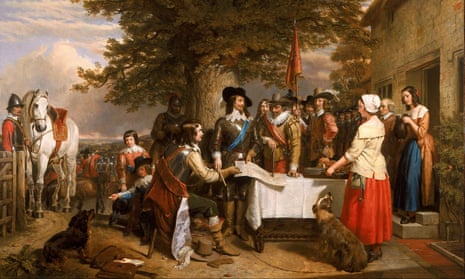In the summer of 1642, on the eve of the English civil war, the plight of a soldier in the army of Charles I was described in a pamphlet. The soldier was exposed as a woman called Nan Ball, “a poor loving wench … taken in man’s cloathes, waiting upon her beloved Lieutenant”.
The lieutenant was sacked and the woman threatened with a public flogging, but she was reprieved, reputedly after a remarkable plea for clemency from the king’s nine-year-old son, James.
Her case is one of the few documented examples of women cross-dressing to take their place alongside soldiers, uncovered by Mark Stoyle, professor of early modern history at the University of Southampton, after trawling through hundreds of original manuscripts and books.
In 1645, Oliver Cromwell, then a lowly second in command, captured a royalist aristocrat, Lord Henry Percy, and a group of supporters. Cromwell noted “a youth of so faire a countenance, that he doubted of his condition; and to confirm himself, willed him to sing” – which the prisoner did “with such daintiness” that her true sex was revealed.
The parliamentarians gleefully regarded the discovery as proof that the king’s supporters were “loose and wanton, and minded their pleasure, more than either their Country’s service, or their Maister’s good”.
There were, however, also women in the parliamentary ranks. A pamphlet in 1645 described a young foot soldier in the parliamentary garrison at Gloucester, who betrayed herself when she visited a tailor and ordered a petticoat “for my sister”.
The suspicious tailor informed the military authorities, and the soldier was unveiled as a woman – who had originally disguised herself in fear of royalist troops before taking up arms against them.
Although some historians have claimed many women cross-dressed during that period for protection, in refusal to separate from their menfolk or, in the case of sex workers, as a turn-on to clients, Stoyle says that apart from a handful of named individuals, his hunt turned up only “fleeting glimpses of women in male attire”.
Such women had long been denounced in sermons and books. James I had ordered clergy to preach against “the insolence of our women, and their wearing of broad brimmed hats and pointed doublets with their haire cut short”. In 1628, the Puritan William Prynne thundered against women “hermaphrodited and transformed into men … even in the odious, if not whorish, cutting of their haire”.
Some were seen as heroic: a ballad sung for decades after the civil war told of a woman besieged in Chester with her husband, who rode out to battle after crying ‘Put mee on a man’s attire, Give mee a Souldier’s coat”.
However hard to find in the records, such women were common enough for Charles I to add a handwritten note to a draft proclamation on standards of behaviour for his army in 1645, warning: “Lett no woman presume to counterfeit her sex by wearing mans apparall under payne of the severest punishment.”
Stoyle, who publishes his research in History, the Journal of the Historical Association, regards the note as fascinating. “These words suggest the king believed female cross-dressing was quite widespread in his army and show a willingness on his part to take a much firmer line on the practice … Curiously though, when the proclamation was finally published it contained no reference to cross-dressing.”







